#king carol ii of romania
Text

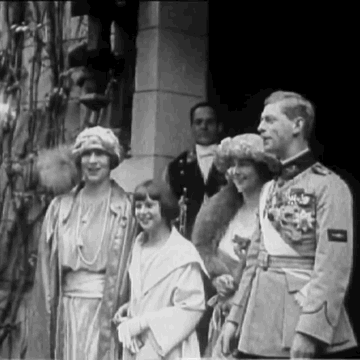


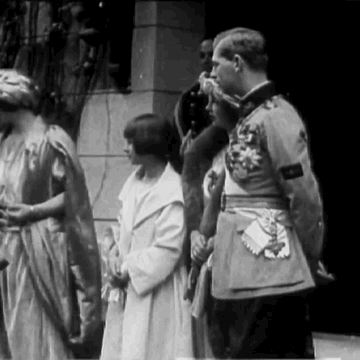
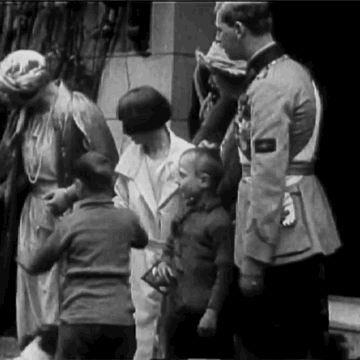
Crown Princess Helen of Romania, Princess Ileana of Romania, Princess Maria of Romania and Crown Prince Carol of Romania in 1921, shortly after the princely’s couple arrival in Romania following their wedding.
Source: ANF.
#romanian royal family#helen queen mother of romania#princess ileana of romania#queen maria of yugoslavia#king carol ii of romania
53 notes
·
View notes
Text

Crown Princess Marie of Romania with her three eldest children.
#queen marie of romania#king carol ii of romania#princess elisabetha of romania#princess maria of romania#princess mignon of romania#portrait
64 notes
·
View notes
Text

#Queen Marie of Romania#King Ferdinand of Romania#Carol II of Romania#Princess Elisabeth of Romania#1890s#colorization#Romania
7 notes
·
View notes
Text
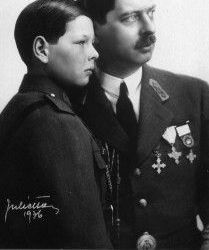
4 notes
·
View notes
Photo

“BOY PRINCE AND HIS AIDES - Crown Prince Michael lost the throne of Rumania when his father, prodigal King Carol, returned from exile. But he still has a "court" of his own, composed of young fellow cadets. This picture shows him surrounded by his military-looking, even if youthful, staff. The boy prince, who once ruled his native country as king, still usually attends important state ceremonies.
- from the Hamilton Spectator. December 20, 1930. Page 7.
#romania#kingdom of romania#carol ii of romania#romanian history#king of romania#interwar period#royal coup#crown prince michael of romania#boy prince#military cadets#the great depression
3 notes
·
View notes
Photo

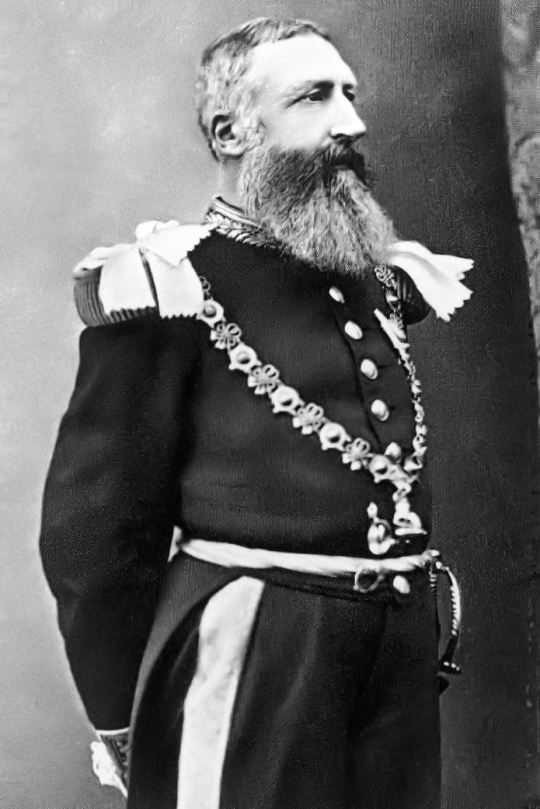
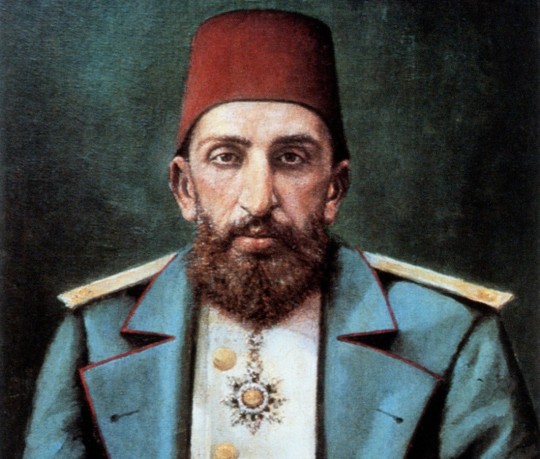

The throne of Holland is not alone in lacking a direct heir. Until recently those of Russia and Italy were at a similar disadvantage. So was that of Servia, or the tragedy of Alexander and Draga had never happened. The mysterious and appalling end of the Prince Rudolf robbed Austria of her heir, and the throne is now destined to be occupied by the Emperor's nephew, the Archduke Franz Ferdinand whose morganatic marriage to the Countess Sophia Choteknow, now Princess of Hohenberg, has cut off the rights of his children to succeed him. King Leopold has for heir his younger brother, a man bordering on seventy. The King of Roumania must leave his crown of iron, the iron of the Turkish guns at Plevna, to Prince Ferdinand, while Abdul Hamid, who took his ensanguined sceptre from the hands of one brother, will all things being normal, pass it on to another brother. Failing an heir to the Netherlandish throne, its next occupant, if he survived the Queen Wilhelmina, would be the wealthy young widowed Grand Duke of Saxe-Weimar, himself childless.
The Sketch Aug 1, 1906
#Grand Duke Wilhelm Ernst of Saxe-Weimar#Sultan Abdul Hamid#King Carol I of Romania#King Leopold II of Belgium#Queen Wilhelmina#1900s#magazine article
11 notes
·
View notes
Text
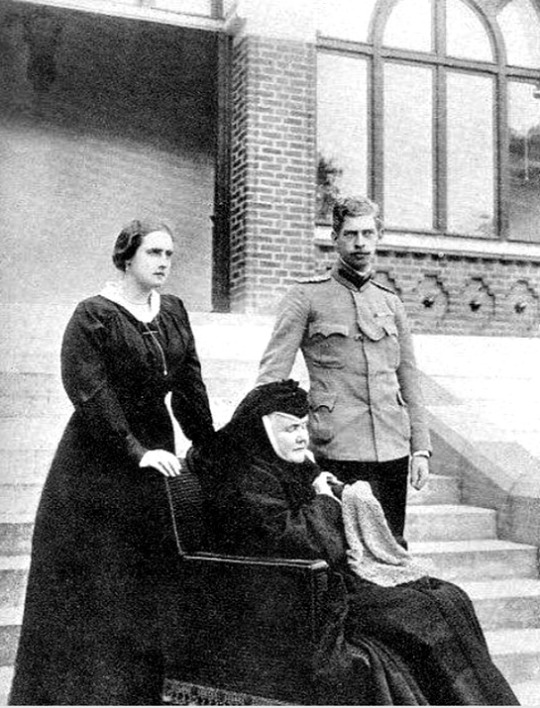
Princess Elisabeth, Prince Carol (later King Carol II) and Queen Elisabeth of Wied.
#p#m#king carol ii#elisabeth of greece#elisabeth of wied#queen elisabeth of romania#queen elisabeth of greece#princess elisabeth of romania
3 notes
·
View notes
Text
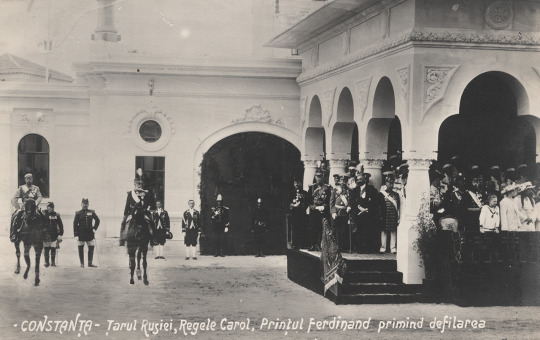
The Russian Imperial Family visit Romania, 1914.
On the left we see Nicholas II on horseback with King Carol of Romania. On the right, we see Prince Nicolae of Romania and his sister Mignon with Grand Duchess Maria Nikolaevna.

#romanov#nicholas ii#maria nikolaevna#otma#carol I of romania#nicolae of romania#nicholas of romania#maria of romania#mignon of romania#romanian royal family#my collection
53 notes
·
View notes
Text

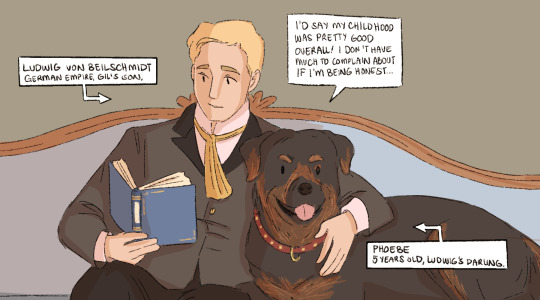

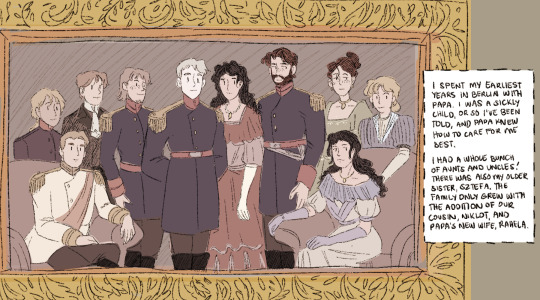


"I was always more of a quiet kid, greatly preferring my books and toys, and the company of those that I was familiar with. I suppose that's why Fritz and I got on well -- We were of the same temperament and had more than a couple shared interests.
Being a part of such an unconventional family hasn't always been easy... Especially now that I'm more grown and am more aware of tensions brought about by politics and the like. But I wouldn't change it for the world."
Portrait descriptions under the cut!!
Portrait 1: The Berlin Family, painted in more recent times.
(L to R Back)
Otto (Order of St. John), Niklot (Reiner's son, Neubrandenburg), Konrad (Berlin), Gilbert (Prussia), Rahela (Gilbert's wife, Romania), Reiner (Brandenburg), Ilse (Potsdam), Johanna (Koenigsberg),
(L to R Front)
Ludwig (German Empire), Sztefa (Silesia)
- Gilbert and Rahela were wed in 1866, after Prince Karl of Hohenzollern-Sigmaringen came to the Romanian throne as King Carol I of Romania. The marriage is purely political, but the two maintain a cordial and warm friendship. much to Erzsi's dismay
- Niklot is Reiner's son, born from a human lover he had before the 30 Years War. Father and son were only recently reunited in the 1820s.
- Sztefa is Gilbert's adopted daughter, taken in during the First Silesian war, and raised in part by Frederick II. Served in the volunteer corps during the Napoleonic era disguised as a man. Is Ludwig's scary lesbian older sister.
Portrait 2: The Vienna family, painted c. 1830s.
(L to R Back)
Erzsebet (Hungary), Sztefa, Anneliese (Vienna), Roderich (Austria)
(L to R Front)
Ludwig, Gilbert
- Roderich may be bonded to Austria, but his sister Anneliese, who embodies the capital, takes more of a leading role when it comes to government matters.
#answered#ask19thcenturydoctorgilbert#hetalia ask blog#reboot#hws prussia#gilbert beilschmidt#hws germany#ludwig beilschmidt#hws ocs#hws brandenburg#hws berlin#hws potsdam#hws konigsberg#hws hungary#hws austria#hws nyo austria#good LORD thats a lot to tag dsjkksd#welp welcome to lud's crazy family#there's so much tea and drama bubbling under the smiley surface
144 notes
·
View notes
Text
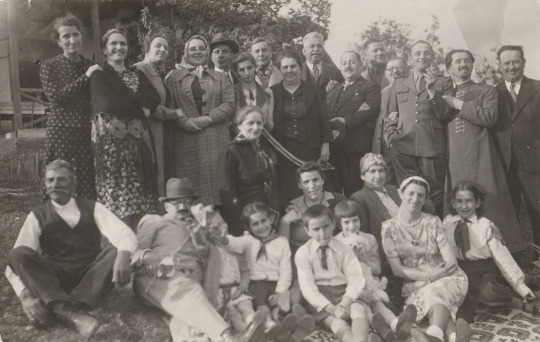


"Amintire de la vie din ziua de 10 Mai 1939. Loti & Radu V. Negulescu. Familie Pr. Alex Popescu." / "Memories de la vie on 10 May 1939. Loti & Radu V. Negulescu. Family of Fr. Alex Popescu."
Found photograph taken, most likely, in Ploiești, Romania. This came from a larger group of photographs relating to Pr. Alexandru Popescu-Strejnicu (1898–?), an Orthodox priest who served as deacon of Catedrala Sf. Ioan Botezătorul in Ploiești between 1924 and 1937. I previously posted a childhood photo of him (and a bit more information) here.
Alexandru Popescu-Strejnicu stands in the back, holding the arm of the man smoking a cigarette. Another interesting detail is the children in the front: three of them wear Straja Țării uniforms, and two are giving the SȚ salute (a variant of a Roman salute). SȚ was a monarchist youth group founded under King Carol II in 1935 as a kind of counter to the Legionary Movement/Iron Guard; it grew in influence after 1938 (during Carol II's so-called "royal dictatorship"/the National Renaissance Front government and ban on other political parties) but disappeared in September 1940 with the foundation of the National Legionary State.
Photo found in Bucharest, 4 April 2024.
13 notes
·
View notes
Text
Our Contestants
1: Maria Leopoldina of Austria, First Empress of Brazil
2 Dona Maria I of Portugal
3: Dona Maria II of Portugal
4: Isabel, Princess Imperial of Brazil
5 Carlota Joaquina de Bourbon
6: João I, Duke of Bragança
7 João IV, King of Portugal
8: Afonso I, Duke of Bragança
9: Fernando I, Duke of Bragança
10: Jaime I, Duke of Bragança
11: Teodósio I, Duke of Bragança
12: Teodósio II, Duke of Bragança
13: Afonso VI of Portugal
14 Pedro II of Portugal
15: João V of Portugal
16: João VI of Portugal
17: Pedro II of Portual
18 Pedro I of Brazil/ IV of Portugal
19: Miguel I of Portugal
20: Pedro V of Portugal
21: Luís I of Portugal
22: Carlos I of Portugal
23: Manuel II of Portugal
24 Dom Pedro II of Brazil
25: Teresa Cristina, Empress of Brazil.
26: Catherine de Bragança, Queen Consort of England, Scotland, and Ireland
27: Infante Dom Manuel, Candidate for the throne of Poland
28: José I of Portugal
29: Carol II of Romania (Carlos II in Portuguese)
30: Ferdinand I of Romania
31: Infantá Antonia de Bragança, Princess Consort of Hohenzollern
32: Amélie of Leuchtenberg
33: Infanta Isabel Maria, Regent of Portugal
34: Mariana Vitória of Spain, Queen Consort of Portugal
35: Maria Francisca of Savoy (Consort to Afonso VI and Pedro II)
36: Maria Pia of Savoy (Queen-Consort to Luís I of Portugal)
6 notes
·
View notes
Photo

Lievin de Winne - Portrait of Marie of Hohenzollern-Sigmaringen - ca 1870

Princess Marie Luise Karoline Alexandra of Hohenzollern-Sigmaringen (17 November 1845 – 26 November 1912), later Countess of Flanders, was a princess of Hohenzollern-Sigmaringen, later simply of Hohenzollern. She married Prince Philippe, Count of Flanders, second son of King Leopold I of Belgium, and she was the mother of King Albert I.
Prince Philippe of Belgium, Count of Flanders (Dutch: Filips; 24 March 1837 – 17 November 1905), was the third born and second surviving son of King Leopold I of Belgium and Louise d'Orléans.
Born at the Château de Laeken, near Brussels, Belgium, Philippe was created Count of Flanders on 14 December 1840. Upon the death of his nephew Prince Leopold, Duke of Brabant, he became heir presumptive to the Belgian throne. In 1866, after the abdication of Alexandru Ioan Cuza, Prince of Romania, Philippe refused being named the new Romanian sovereign, and the throne was later accepted by Philippe's brother-in-law Carol I.[1] Earlier, he had also refused the crown of Greece, which was offered to him in 1862.
Philippe died in 1905. When his brother King Leopold II died in 1909, Philippe's second son ascended the Belgian throne as King Albert I.
Liévin De Winne (Ghent, 24 January 1821 - Brussels, 13 May 1880) was a Belgian portrait painter who painted the official portrait of Leopold I on which the first postage stamp of Belgium was based.
42 notes
·
View notes
Photo

“In his youth King Carol II of Romania was a handsome man, but unfortunately his personality was not beautiful.” - Submitted by Anonymous
12 notes
·
View notes
Note
May I ask who were the possible royal suitors of OTMA and A lexei
Hello!
As I know to Olga there was Prince Ioann Konstantinovich, King Carol II of Romania, King Edward VIII of U.K and King Alexander I of yugoslavia. Some sources also speak about King George VI of U.K and Grand Duke Dmitri Pavlovich. There was also Grand Duke Constantine Constantinovich (he had a crush on her) and Grand Duke Boris Vladimirovich. Prince Christopher of Greece loved her and tried to marry her but Nicholas declined the offer.
To Tatiana there was King Alexander I of Yugoslavia (sources said the he was in love with her), King George VI of U.K and Prince Adalbert of Bavaria.
To Maria there was Prince Louis of Battenberg. King Carol II of Romania asked for her hand but Nicholas declined.
To Anastasia, some sources speak about King Leopold III of Belgium.
Boris of Bulgaria, Peter of Montenegro and Prince Arthur (son of Prince Arthur Duke of Connaught) were also mentioned as possible husbands for the girls.
As for Alexei there was Ileana of Romania, Princess Ingrid (she became Queen of Denmark). Others princesses of Norway and Greece were mentioned too.
17 notes
·
View notes
Photo

“King Carol Is Acclaimed On Return to Bucharest,” Owen Sound Sun Times. June 20, 1930. Page 9.
---
This photograph shows King Carol riding through the streets of Bucharest in company with his brother, Prince Nicholas, to replace his son, 9-year-old Michael, as King of Roumania.
#bucharest#romania#kingdom of romania#carol ii of romania#romanian history#royal coup#coup d'etat#king of romania#return from exile#the great depression#interwar period
4 notes
·
View notes
Text
Events 11.27 (before 1950)
AD 25 – Luoyang is declared capital of the Eastern Han dynasty by Emperor Guangwu of Han.
176 – Emperor Marcus Aurelius grants his son Commodus the rank of "Imperator" and makes him Supreme Commander of the Roman legions.
395 – Rufinus, praetorian prefect of the East, is murdered by Gothic mercenaries under Gainas.
511 – King Clovis I dies at Lutetia and is buried in the Abbey of St Genevieve.
602 – Byzantine Emperor Maurice is forced to watch as the usurper Phocas executes his five sons before Maurice is beheaded himself.
1095 – Pope Urban II declares the First Crusade at the Council of Clermont.
1542 – Palace plot of Renyin year: A group of Ming dynasty palace women fail to murder the Jiajing Emperor, and are executed by slow-slicing.
1727 – The foundation stone to the Jerusalem Church in Berlin is laid.
1809 – The Berners Street hoax is perpetrated by Theodore Hook in the City of Westminster, London.
1815 – Adoption of the Constitution of the Kingdom of Poland.
1830 – Saint Catherine Labouré experiences a Marian apparition.
1835 – James Pratt and John Smith are hanged in London; they are the last two to be executed for sodomy in England.
1839 – In Boston, Massachusetts, the American Statistical Association is founded.
1856 – The Coup of 1856 leads to Luxembourg's unilateral adoption of a new, reactionary constitution.
1863 – American Civil War: Confederate cavalry leader John Hunt Morgan and several of his men escape the Ohio Penitentiary and return safely to the South.
1863 – American Civil War: Battle of Mine Run: Union forces under General George Meade take up positions against troops led by Confederate General Robert E. Lee.
1868 – American Indian Wars: Battle of Washita River: United States Army Lieutenant Colonel George Armstrong Custer leads an attack on Cheyenne living on reservation land.
1895 – At the Swedish–Norwegian Club in Paris, Alfred Nobel signs his last will and testament, setting aside his estate to establish the Nobel Prize after he dies.
1896 – Also sprach Zarathustra by Richard Strauss is first performed.
1901 – The U.S. Army War College is established.
1912 – Spain declares a protectorate over the north shore of Morocco.
1917 – P. E. Svinhufvud becomes the chairman of his first senate, technically the first Prime Minister of Finland.
1918 – The Makhnovshchina is established.
1924 – In New York City, the first Macy's Thanksgiving Day Parade is held.
1940 – In Romania, the ruling Iron Guard fascist party assassinates over 60 of arrested King Carol II of Romania's aides and other political dissidents.
1940 – World War II: At the Battle of Cape Spartivento, the Royal Navy engages the Regia Marina in the Mediterranean Sea.
1942 – World War II: At Toulon, the French navy scuttles its ships and submarines to keep them out of Nazi hands.
1944 – World War II: RAF Fauld explosion: An explosion at a Royal Air Force ammunition dump in Staffordshire kills seventy people.
1945 – CARE (then the Cooperative for American Remittances to Europe) is founded to send CARE Packages of food relief to Europe after World War II.
1 note
·
View note